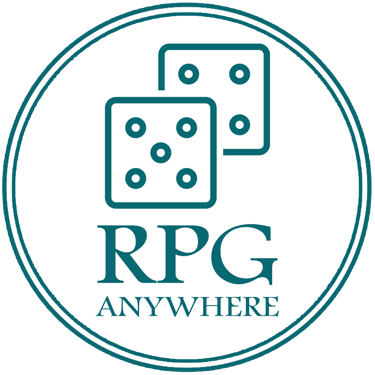Infinite Horizons: Game Mechanics
Resolving actions, handling combat, and tracking damage in Infinite Horizons is simple. These mechanics are designed to be intuitive, flexible, and directly support the narrative flow of your adventures.
Story Play & Dice Rolls
In Infinite Horizons, when your character wants to accomplish something challenging or risky, the first step isn't to grab dice; it's to describe what your character is trying to do and how they are attempting it. This "how" is crucial, as it determines which Trait and Skill will be used for your roll.
Describing Your Intent
What do you want to accomplish? Clearly state your character's goal. For example, "I want to open that locked door," "I want to convince the guard to let us pass," or "I want to swing across the chasm."
How do you accomplish it? Describe your character's method or approach. This is where your Traits and Skills come into play.
Are you using brute force, stealth, cunning, charm, or something else?
Are you relying on a learned ability, raw talent, or both?
Your Game Master (GM) will then identify the most appropriate Trait and Skill combination based on your description. Sometimes, there might be multiple valid approaches, and your GM will ask you to choose the one that best fits your character's style.
The Core Roll: Building Your Dice Pool
Once the Trait and Skill are determined, you'll build your dice pool to see if your character succeeds. The core mechanic in Infinite Horizons is simple:
You start with a base of 1 die. You then add your relevant Trait score and your relevant Skill score to determine the total number of dice in your dice pool.
1 (base die) + Trait + Skill = Your Dice Pool
You then roll this number of dice. Each die that rolls a 7 or better counts as a Success.
Exploding Dice for Critical Success!
Whenever you roll a 10 on any die in your dice pool, it counts as a Success, and then you get to roll that die again! This new roll can also generate successes and potentially explode again if you roll another 10. There's no limit to how many times a die can explode, allowing for truly exceptional outcomes.
The GM will tell you how many Successes are needed for the task. If you roll enough Successes, you succeed! More Successes often mean a better outcome, faster completion, or additional benefits.
Example: You want to pick a lock on a heavy vault door. You tell the GM, "I carefully examine the tumblers and use my lock-picking tools."
The GM determines this is a Finesse (for dexterity) + Thievery (for lock-picking knowledge) roll.
If your character has Finesse 3 and Thievery 2, your dice pool is 1 (base) + 3 (Finesse) + 2 (Thievery) = 6 dice.
You then roll those 6 dice, counting any 7s, 8s, 9s, or 10s as Successes. If any die rolls a 10, you roll that die again. The GM might require 3 successes to open the vault.
Example: You need to cross a roaring river. You tell the GM, "I'll try to leap across the narrowest point with all my might."
The GM determines this is a Body (for raw strength) + Athletics (for jumping prowess) roll.
If your character has Body 4 and Athletics 1, your dice pool is 1 (base) + 4 (Body) + 1 (Athletics) = 6 dice.
You then roll those 6 dice, looking for Successes (7, 8, 9, or 10) and exploding 10s. The GM might require 2 successes to safely clear the river.
Example: When trying to Intimidate someone, the Trait you use depends on your approach:
Using your Presence for sheer force of personality or a menacing aura.
Using your Body for overt physical threat, a display of brute strength, or a menacing posture.
Using your Wits for subtle psychological pressure, revealing compromising information, or making a chillingly precise threat.
This core mechanic is the heart of resolving actions in Infinite Horizons, allowing for flexible and descriptive play while quickly determining the outcome of risky endeavors.
Combat, Damage, and Opposed Roles
In Infinite Horizons combat, actions unfold simultaneously, and the number of successes you achieve, or those your opponent achieves, directly tells the story of who gains the upper hand. There are no separate “damage rolls”. All outcomes are resolved directly through the exchange of successes.
All of the following are optional. Infinite Horizons can be played with or without wounds, stability and mitigation – all depending on your story setting and table.
Opposed Rolls: Successes in Direct Conflict
When two characters are directly opposing each other in combat (e.g., an attack and a parry, or two characters grappling), you both roll your respective dice pools.
Net Successes: Compare the total number of successes each participant achieved. The character with more successes wins the exchange, and their net successes are the difference between their successes and their opponent’s.
Example: You roll for your attack and get 4 successes. Your opponent rolls for their defense (dodge or parry) and gets 2 successes. You have 2 net successes (4 - 2 = 2). This means your attack has a significant impact.
Example: You roll for your attack and 3 successes. Your opponent rolls for their defense and gets 5 successes. Your opponent has 2 net successes (5 - 3 = 2). They have successfully negated your attack, potentially gaining an advantage or even striking back.
Damage Mitigation: Shrugging Off Injury
Instead of making an extra roll to defend, a character’s natural resilience and armor provide a static Damage Mitigation value. This value is subtracted from the successes of an incoming attack, absorbing a certain amount of punishment.
Damage Tracking: The Wound Track
Instead of a numerical Health Pool, your character tracks damage using a visual Wound Track, divided into three escalating tiers: Minor, Major, and Critical.
The number of boxes in your Minor Wound Track is determined by your character’s combined resilience: 4 + your Body Trait score + your Resolve Trait score (to a maximum of 10).
Your Major and Critical Wound Tracks each have a fixed 4 boxes.
When your character takes damage, you mark off boxes in the appropriate tier.
Once all boxes in a given tier are filled, any further damage that would go into that tier instead spills over and fills boxes in the next higher tier.
For example, if all your Minor boxes are filled, and you take another source of Minor damage, it instead fills one Major box.
If all your Major boxes are filled, and you take Major damage, it fills a Critical box.
Stability: Tracking Your Mental Fortitude
While the Wound Track handles physical damage, Stability is a measure of your character’s mental and emotional resilience. This is particularly relevant in horror, mystery, or cosmic genres where characters face shocking, surreal, or psychologically damaging events.
When your Stability track is completely filled, your character suffers a mental breakdown. They are effectively incapacitated or insane and may gain a temporary or permanent mental condition (e.g., a phobia, a new personality quirk, a period of catatonia). They can still take actions, but will likely begin working to actively hinder the rest of the group.

